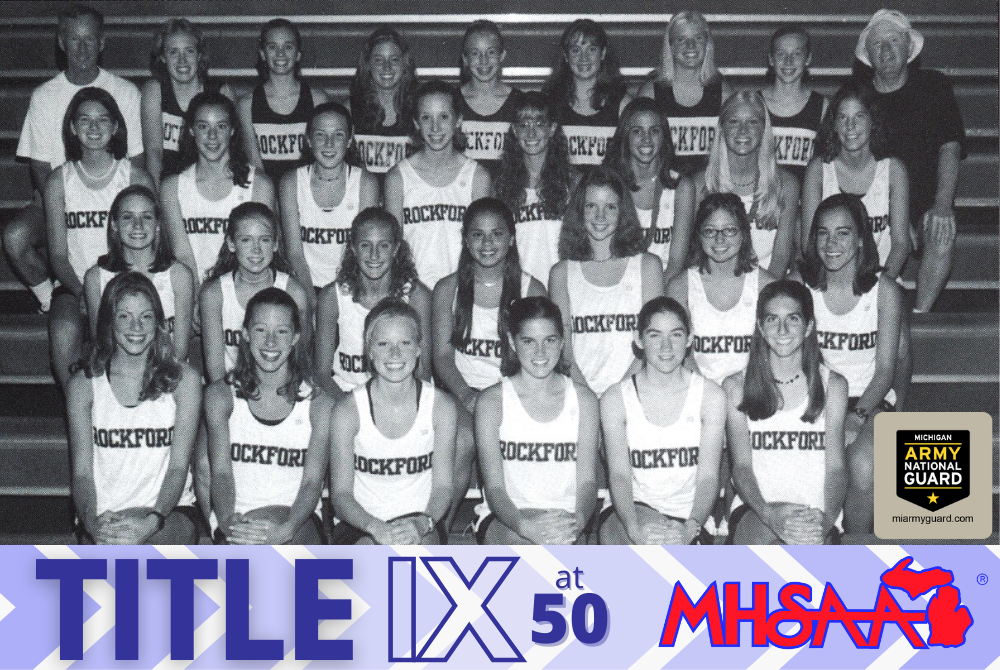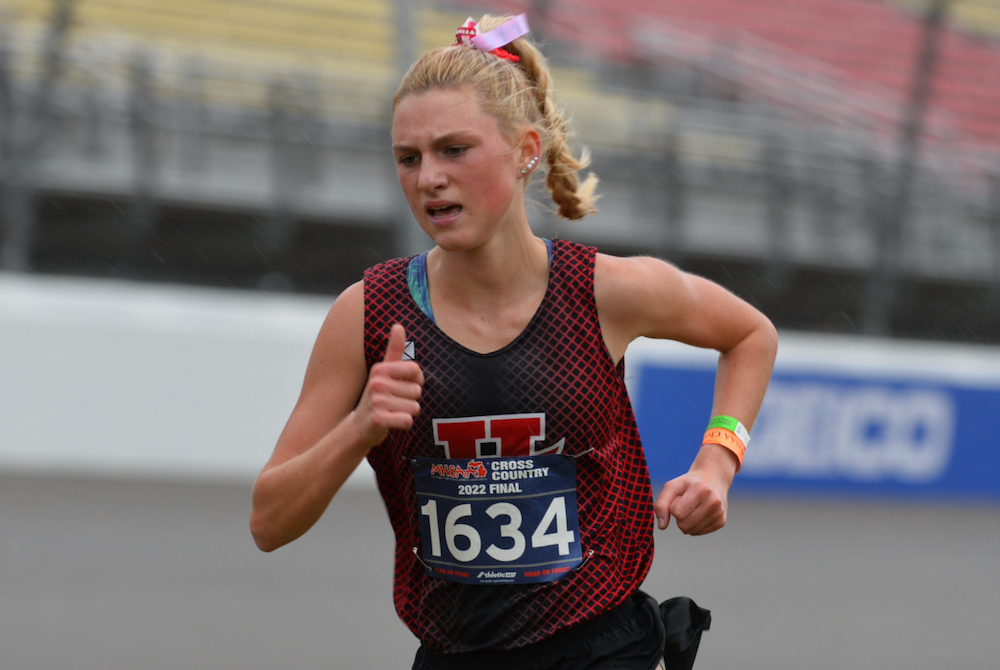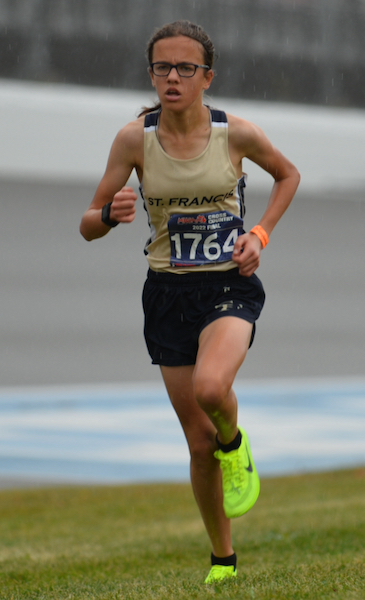
Title IX at 50: Rockford Girls Set Pace, Hundreds After Have Continued to Chase
By
Geoff Kimmerly
MHSAA.com senior editor
October 19, 2021
Michigan’s high school cross country teams have entered the home stretch of the 2021 season, with the championship races in both peninsulas to be run over the next three weekends.
For more than two decades, the best girls teams of the Lower Peninsula’s biggest schools have been chasing the 2000 Rockford Rams.
That season was the first of the MHSAA classifying its championship groupings using four equal divisions, and Rockford set a standard that few have approached as we near the completion of the first quarter of the 21st century.
Rockford won the Lower Peninsula Division 1 championship Nov. 4, 2000, at Michigan International Speedway with 35 points – 77 fewer than runner-up Milford and 197 fewer than third-place Troy. Five Rams finished among the top 15 individuals – senior Lindsey Blaisdell third, senior Kalin Toedebusch fourth, sophomore Nicole Bohnsack fifth, sophomore Kelsey Toedebusch ninth and senior Aimee Keenan 15th, which was actually 14th among runners involved in team scoring.
The next lowest Lower Peninsula Division 1 Finals score was achieved two seasons later, again by Rockford, with a 57. Four more Lower Peninsula teams have scored in the 30s since the dawn of the divisions era – East Grand Rapids won Division 2 in 2019 with 36 points, while Mount Pleasant Sacred Heart broke Rockford’s LP record winning Division 4 with 34 points in 2016 before coming back to win again with 39 in 2017.
Rockford’s 2000 championship was its third of five straight, which remains the longest Finals title streak in Lower Peninsula history. Bohnsack went on to win the LPD1 individual championships as well in 2001 and 2002 and run collegiately at Penn State. Kalin Toedebusch ran at Colorado, Blaisdell ran at Wisconsin and Keenan ran at Michigan State. The first four of those five straight championship teams were coached by Brad Prins.
Second Half's weekly Title IX Celebration posts are sponsored by Michigan Army National Guard.
Previous Title IX at 50 Spotlights
Oct. 12: Bedford Volleyball Pioneer Continues Blazing Record-Setting Trail - Read
Oct. 5: Warner Paved Way to Legend Status with Record Rounds - Read
Sept. 28: Taylor Kennedy Gymnasts Earn Fame as 1st Champions - Read
Sept. 21: Portage Northern Star Byington Becomes Play-by-Play Pioneer - Read
Sept. 14: Guerra/Groat Legacy Continues to Serve St. Philip Well - Read
Sept. 7: Best-Ever Conversation Must Include Leland's Glass - Read
Aug. 31: We Will Celebrate Many Who Paved the Way - Read

Jazwinski Brings Hart Individual Title as St. Francis Moves to Front of Team Pack
November 5, 2022
BROOKLYN – Cross country races can be won between the ears before runners ever step foot onto the course.
Attitudes were tested as rain began to descend on Michigan International Speedway and the wind picked up just before the start of the MHSAA Lower Peninsula Division 3 girls race late Saturday morning.
Hart sophomore Jessica Jazwinski was loving life as she prepared to race.
“As a distance runner, I really try to love the wind,” she said. “Distance running and cross country is just a tough sport. The wind just adds to it — and the rain, too. It’s super fun.
“I was just thinking these conditions are just gonna feed my great race. This is real cross country. Yeah!”
Jazwinski overcame the elements to run the fifth-fastest Division 3 time ever, winning with a time of 17:36.70. She has two of the top-five times in Division 3 Finals history, having run 17:31.4 to place third last year.
“Today my race plan was just to go out hard and try to hold on to my pace,” she said. “I feel like I tried to race a lot like Steve Prefontaine, just go out and hold on.”
 Lansing Catholic senior Hannah Pricco was second in 18:17.59, Onsted sophomore Emmry Ross was third in 18:20.96 and Hart junior Alyson Ens was fourth in 18:28.52.
Lansing Catholic senior Hannah Pricco was second in 18:17.59, Onsted sophomore Emmry Ross was third in 18:20.96 and Hart junior Alyson Ens was fourth in 18:28.52.
“I love having great teammates to work with and encourage each other,” Jazwinski said. “We really try to encourage each other so much throughout the races. Throughout this year, some races she’s been a minute behind me, some races she’s been five seconds. I don’t want her to ever beat me, so that pushes me so much. I know she’s trying to race me and get up there with me.”
The only downer for Hart was having its string of Division 3 championships end at five with a fourth-place finish. Hart had two runners in the top four, but its No. 3 runner was 68th.
“I would totally trade my individual title for a team title,” Jazwinski said.
Traverse City St. Francis emerged from a close battle to win its first title since 2016 with 134 points. Pewamo-Westphalia was second with 142 and Lansing Catholic third with 165.
Sophomore Betsy Skendzel led St. Francis, placing seventh in 18:48.33. Completing the team score were senior Sophia Rhein in 26th (19:43.27), sophomore Grace Slocum in 33rd (20:07.95), junior Rylee Duffing in 60th (20:44.82) and junior Margot Hagerty in 63rd (20:45.78).
Lansing Catholic had three place in the top 10, but didn’t get another finisher until 103rd.
PHOTOS (Top) Hart’s Jessica Jazwinski pushes toward the finish during Saturday’s LPD3 Final. (Middle) Traverse City St. Francis’ Betsy Skendzel leads the way for the eventual team champion. (Click for more from Dave McCauley/RunMichigan.com.)

